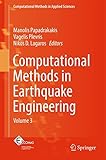Computational Methods in Earthquake Engineering [electronic resource] : Volume 3 / edited by Manolis Papadrakakis, Vagelis Plevris, Nikos D. Lagaros.
Contributor(s): Papadrakakis, Manolis [editor.] | Plevris, Vagelis [editor.]
| Plevris, Vagelis [editor.] | Lagaros, Nikos D [editor.]
| Lagaros, Nikos D [editor.] | SpringerLink (Online service)
| SpringerLink (Online service) .
.
Material type:  BookSeries: Computational Methods in Applied Sciences: 44Publisher: Cham : Springer International Publishing : Imprint: Springer, 2017Edition: 1st ed. 2017.Description: X, 418 p. 182 illus. online resource.Content type: text Media type: computer Carrier type: online resourceISBN: 9783319477985.Subject(s): Civil engineering
BookSeries: Computational Methods in Applied Sciences: 44Publisher: Cham : Springer International Publishing : Imprint: Springer, 2017Edition: 1st ed. 2017.Description: X, 418 p. 182 illus. online resource.Content type: text Media type: computer Carrier type: online resourceISBN: 9783319477985.Subject(s): Civil engineeringPreface -- 1. Numerical Modeling Aspects of Buried Pipeline – Fault Crossing, by Vasileios E. Melissianos and Charis J. Gantes -- 2. Determination of the parameters of the directivity pulse embedded in near-fault ground motions and its effect on structural response, by Petros Mimoglou, Ioannis N. Psycharis and Ioannis M. Taflampas -- 3. Numerical Simulation of Liquid Sloshing in Tanks, by Zuhal Ozdemir, Yasin M. Fahjan and Mhamed Souli -- 4. Seismic Analysis of Structural Systems Subjected to Fully Non-Stationary Artificial Accelerograms, by Giuseppe Muscolino and Tiziana Alderucci -- 5. Elastic and Inelastic Analyses of Frames with a Force-based Higher-order 3D Beam Element Accounting for Axial-flexural-shear-torsional Interaction, by João P. Almeida, António A. Correia, and Rui Pinho -- 6. Improved Method for the Calculation of Plastic Rotation of Moment-Resisting Framed Structures for Nonlinear Static and Dynamic Analysis, by Kevin K.F. Wong and Matthew S. Speicher -- 7. Seismic demand on acceleration-sensitive nonstructural components, by Gennaro Magliulo, Crescenzo Petrone and Gaetano Manfredi -- 8. Design of RC Sections with Single Reinforcement according to EC2-1-1 and the Rectangular Stress Distribution, by Vagelis Plevris and George Papazafeiropoulos -- 9. Multi-Storey Structures with Seismic Isolation at Storey-levels, by Marios C. Phocas and George Pamboris -- 10. Integration step size and its adequate selection in analysis of structural systems against earthquakes, by Aram Soroushian -- 11. Seismic fragility analysis of faulty smart structures, by Yeesock Kim and Jong-Wha Bai -- 12. Actuating connections for substrusture damage identification and health monitoring, by Stavros Chatzieleftheriou and Nikos D. Lagaros -- 13. Fuzzy Neural Network Based Response of Uncertain System Subject to Earthquake Motions, by S. Chakraverty and Deepti Moyi Sahoo -- 14. Smart control of seismically excited highway bridges, by Yeesock Kim and Aniket Anil Mahajan -- 15. A Real-Time Emergency Inspection Scheduling Tool Following a Seismic Event, by Nikos Ath. Kallioras and Nikos D. Lagaros. .
This is the third book in a series on Computational Methods in Earthquake Engineering. The purpose of this volume is to bring together the scientific communities of Computational Mechanics and Structural Dynamics, offering a wide coverage of timely issues on contemporary Earthquake Engineering. This volume will facilitate the exchange of ideas in topics of mutual interest and can serve as a platform for establishing links between research groups with complementary activities. The computational aspects are emphasized in order to address difficult engineering problems of great social and economic importance. .


There are no comments for this item.